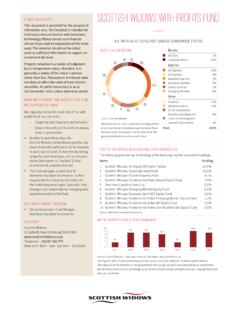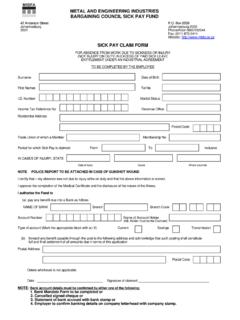Transcription of Offshore Hedge Funds vs. Onshore Hedge Funds - …
1 Offshore Hedge Funds vs. Onshore Hedge Funds A fund Associates White Paper, December 2008. White Paper, December 2008 Offshore Hedge Funds Vs. Onshore Hedge Funds Offshore Hedge Funds vs. Onshore Hedge Funds I. Who May Invest In Offshore Hedge Funds Investors in Offshore Hedge Funds are comprised of individuals and institutions as well as tax- exempt institutions. Institutional investors include entities such as pension Funds , endowments, foundations, and other pools of capital whose assets are managed by a group of fiduciaries. Since Offshore Funds operate on the assumption that the assets they accept are not subject to taxes in the investor's home jurisdiction, they have no obligation to compile the information needed for an investor to calculate and pay taxes. This means that for practi- cal purposes, taxable investors are prevented from participating directly in Offshore Funds , because although they would be legally obligated to report and pay tax on any taxable income earned in the fund , their fund man- ager would be unlikely to supply them with the relevant information.
2 II. General Structural Differences Between Onshore and Offshore Hedge Funds A. Onshore Hedge Funds Most Hedge Funds domiciled in the are organized as limited partnerships. This is because the limited partnership structure avoids double taxation of investment returns and grants investors (limited partners). limited liability protection, which shields them from losing more than their investment. The general partner is the fund manager and assumes responsibility for management of the fund 's portfolio as well as man- agement of the business of the partnership. As a prudent business practice, fund managers will typically form corporate entities to assume the role of general partner since the general partner has unlimited liability for the partnership's obligations. B. Offshore Hedge Funds In the Offshore arena, Hedge Funds make use of three main vehicles: companies, unit trusts, and limited partnerships.
3 The type of vehicle used is based on investor requirements. 1. Offshore Companies The vast majority of companies are incorporated with limited liability. Some companies may have more than one class of shares, which denote various fee structures and/or denote limitations on the types of investments some shareholders can make. There may also exist multiple series within each class of shares. Companies are the most common Offshore vehicle for both open-end and closed-end Funds . Open-end Funds do not have a fixed number of shares. The number of shares in the fund increas- es when investors add capital to the fund and decreases when current investors withdraw capital from the fund . Closed-end Funds have a fixed number of shares in which existing investors sell White Paper, December 2008 Offshore Hedge Funds Vs.
4 Onshore Hedge Funds shares to new investors and buy shares from leaving investors. Closed-end Funds may also have a tender process whereby the fund offers to buy shares from fund investors on a periodic basis. This has the effect of adding some liquidity to the fund but not nearly the level of liquidity that ex- ists in open-end Funds . 2. Offshore Unit Trusts Formed under a trust deed, a unit trust is an unincorporated mutual fund structure. All unit trusts are open-ended. When investors in a unit trust add Funds to their account, they are held by a trustee who has the option of acting as the custodian or selecting another custodian. The trustee must also make sure that the fund manager sticks to the fund 's investment objectives and perfor- mance goals. fund managers often charge an annual management fee of 1 to 2 percent of the fund 's market value.
5 Assets typically held by unit trusts include property, securities, mortgages, and cash equivalents. Profits from these investments in the form of capital gains, interest, and dividends are paid out tax-free to investors rather than being reinvested back into the fund . Some Onshore investors may have to pay taxes on their profits, but a grace period allows them to collect interest on those profits until their tax bill is due. Offshore unit trusts have continued to grow in popularity for several reasons. In addition to offer- ing favorable tax treatment, they typically have low annual operating expenses and are a cheaper investment vehicle than actively managed mutual Funds even though they may charge sales, entrance, and/or exit fees. Moreover, they offer an easy way to diversify, which helps reduce investment risk.
6 Rather than offering the same investment portfolio to all of its investors, many unit trusts are happy to play the role of a one-stop shop by allowing investors to build and diversify their own portfolios across different asset classes, industries, and markets throughout the world. So instead of investors scattering their money over multiple investment products from multiple Hedge Funds , many of them prefer the convenience of turning to one fund for one product that can be tailored to suit their needs. Since each investor in the fund can be expected to have different risk toler- ances, different performance goals, and different investment strategies, asset allocations will not be uniform throughout the fund 's portfolios. Hence, many Offshore unit trusts must act as umbrella trusts that encompass several smaller sub-trusts (or series trusts ), each of which represents a single investor's portfolio.
7 The main umbrella unit trust must be carefully structured so that the assets and liabilities of each sub-trust are considered separate from the assets and liabilities of other sub-trusts. White Paper, December 2008 Offshore Hedge Funds Vs. Onshore Hedge Funds As an aside, holding units in a unit trust may be more attractive than holding shares in a company in some jurisdictions. It is possible that local regulations may not consider the units to be securi- ties under their domestic securities laws. It is also possible that the jurisdiction may not even recognize concept of a trust. 3. Offshore Limited Partnerships: By dividing the functions of ownership and control, limited partnerships are very effective at pro- tecting assets from seizure by creditors. Private equity Funds with a limited number of investors will often make use of Offshore limited part- nerships.
8 Regarding the Cayman Islands specifically, the Offshore limited partnership vehicle is very popular among investors who tend to already be familiar with Delaware limited partner- ships which the Cayman limited partnership structure is based on. III. Various Purposes For Offshore Funds A. Accommodating Tax-exempt Investors Interested in Avoiding UBTI. Under tax law, a tax-exempt organization (such as an IRA, ERISA-type retirement plan, founda- tion, endowment, etc.) that adopts an investment strategy where money is borrowed is liable for a tax on unrelated business taxable income (UBTI). This presents an income tax issue for the plan as well as a political issue, because it raises the question of why a tax-exempt fund would have to pay income tax. Since pass-through entities such as limited partnerships and limited liability companies comprise the overwhelming majority of Funds , the UBTI activity passes through the entity to the tax-exempt inves- tor, which triggers the tax issue.
9 Taxable investors are not bothered by this, because they have to pay tax anyway. However, it is a cause for concern for tax-exempt investors. By having the tax-exempt entity invest in a ( Offshore ) corporate entity (which is non-pass through), the UBTI tax can be avoided, because the UBTI is effectively trapped inside the corporation and no longer causes trouble for the tax-exempt investor. Consequently, tax-exempt investors are willing to invest Offshore in order to deal with this issue. B. Investors Concerned About Maintaining Anonymity Offshore Hedge Funds organized as corporations are attractive to investors seeking to maintain anonymity with respect to the For example, if an Offshore Hedge fund makes any investments in securities, then withholding tax rules will apply to the fund , and paperwork will have to be filled out to claim exemption from withholding and backup withholding taxes.
10 If the Offshore fund is structured as a partnership, the partners themselves will have to submit these forms, which declares their participation in the fund to tax authorities. However, if the Offshore fund is structured as a corpora- tion, then only the corporate entity will have to submit the paperwork, thus allowing its individual investors to remain anonymous to tax authorities. White Paper, December 2008 Offshore Hedge Funds Vs. Onshore Hedge Funds C. Master-Feeder fund Structure It is common for Hedge fund managers to offer both an Onshore limited partnership for taxable investors as well as an Offshore company for tax-exempt investors and investors, who wish to avoid the tax regulatory net or to remain anonymous to authorities. Arranging the invest- ments of two separate Funds so that each fund has the same asset allocation and is pursuing the same investment strategy can be very difficult.






